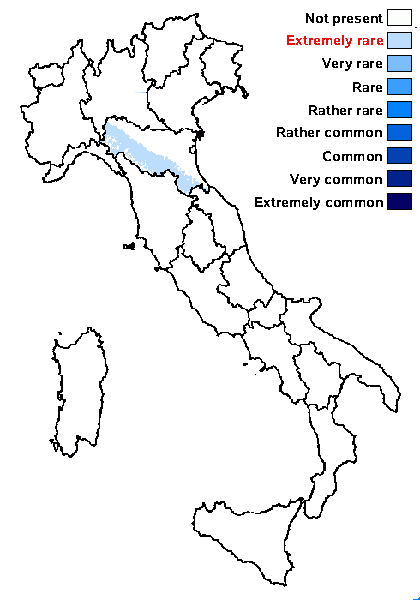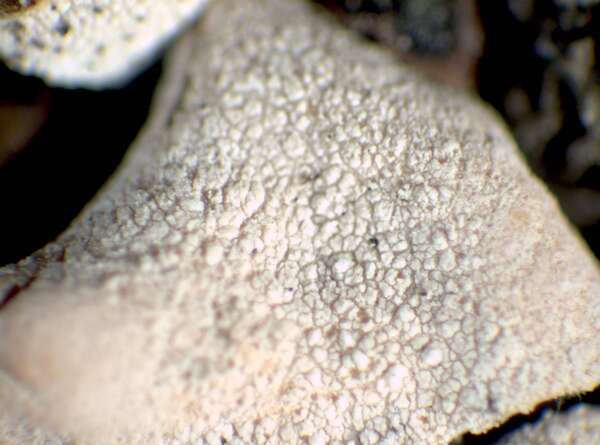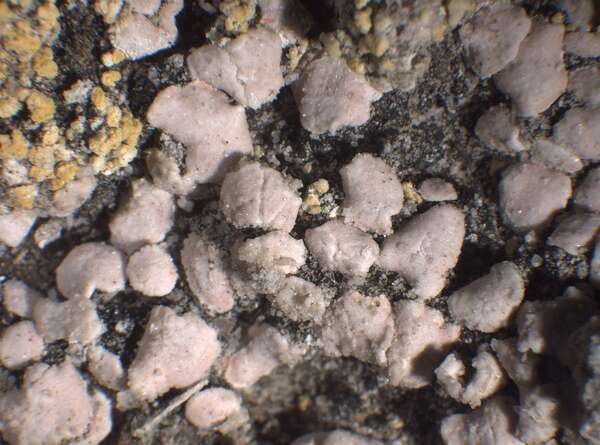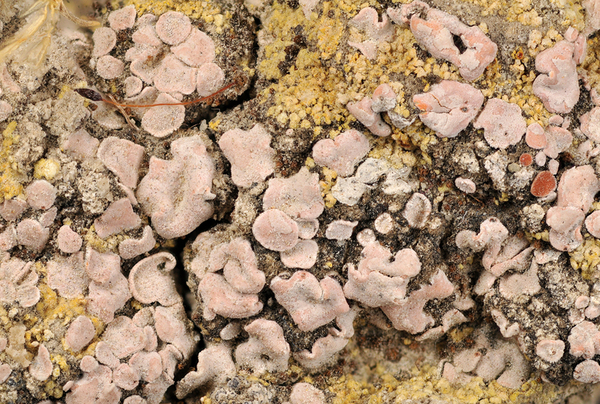Psora saviczii (Tomin) Follmann & A. Crespo
Philippia, 2: 283, 1975. Basionym: Lecidea saviczii Tomin - Nat. Agric. arid Reg. USSR: 47, 1927.
Synonyms:
Distribution: N - Emil (Nimis & al. 1996, Vezda Lich.Rar.Exs. 259, Fariselli & al. 2020).
Description: Thallus squamulose, pale pink to pinkish white, often thinly white-pruinose, the squamules rounded, initially concave, then flattened, dispersed to contiguous, not imbricate, 2-4 mm wide, with down-turned, concolorous or more rarely whitish edges. Upper cortex of thin-walled hyphae with round lumina; lower cortex absent. Apothecia biatorine, sessile, 1-1.5 mm across, with a black, sometimes white-pruinose, convex, smooth disc and an indistinct proper margin. Epithecium reddish brown, containing orange crystals dissolving in K, K+ purple, N-; hymenium colourless, amyloid; paraphyses coherent, stout, simple or sparingly branched and anastomosing, the apical cell slightly swollen; hypothecium brownish, with crystals of calcium oxalate. Asci 8-spored, elongate-clavate, with a thin, outer amyloid layer and a thickened tholus penetrated by a tube, the sides of which stain I/KI+ deep blue, without an ocular chamber, Porpidia-type. Ascospores 1-celled, hyaline, ellipsoid, 11-18 x 6-8 μm, thin-walled. Pycnidia immersed. Conidia bacilliform. Photobiont chlorococcoid. Spot tests: cortex and medulla K-, C-, KC-, P-, UV-. Chemistry: thallus without lichen substances, epithecium with anthraquinones, mainly parietin. Note: a mainly gypsicolous, southern species in Europe, to be looked for in other areas with gypsum outcrops (e.g. in Sicily).
Growth form: Squamulose
Substrata: soil, terricolous mosses, and plant debris
Photobiont: green algae other than Trentepohlia
Reproductive strategy: mainly sexual
Subcontinental: restricted to areas with a dry-subcontinental climate (e.g. dry Alpine valleys, parts of Mediterranean Italy)
Commonnes-rarity: (info)
Alpine belt: absent
Subalpine belt: absent
Oromediterranean belt: absent
Montane belt: absent
Submediterranean belt: very rare
Padanian area: absent
Humid submediterranean belt: absent
Humid mediterranean belt: absent
Dry mediterranean belt: absent

Predictive model
Herbarium samples


P.L. Nimis; Owner: Department of Life Sciences, University of Trieste
Herbarium: TSB (20694)
2001/11/29


P.L. Nimis; Owner: Department of Life Sciences, University of Trieste
Herbarium: TSB (20694)
2001/11/29
detail of pruina


P.L. Nimis; Owner: Department of Life Sciences, University of Trieste
Herbarium: TSB (35722)
2003/01/22

Source: https://nhm2.uio.no/typephotos/lichens/arkiv/O-L-001146d.jpg
RUSSIA: [Cyrillic handwriting], 1926.07.00, Tomin 14 - ISOTYPE
Growth form: Squamulose
Substrata: soil, terricolous mosses, and plant debris
Photobiont: green algae other than Trentepohlia
Reproductive strategy: mainly sexual
Subcontinental: restricted to areas with a dry-subcontinental climate (e.g. dry Alpine valleys, parts of Mediterranean Italy)
Commonnes-rarity: (info)
Alpine belt: absent
Subalpine belt: absent
Oromediterranean belt: absent
Montane belt: absent
Submediterranean belt: very rare
Padanian area: absent
Humid submediterranean belt: absent
Humid mediterranean belt: absent
Dry mediterranean belt: absent

Predictive model
| Herbarium samples |


P.L. Nimis; Owner: Department of Life Sciences, University of Trieste
Herbarium: TSB (20694)
2001/11/29


P.L. Nimis; Owner: Department of Life Sciences, University of Trieste
Herbarium: TSB (20694)
2001/11/29
detail of pruina


P.L. Nimis; Owner: Department of Life Sciences, University of Trieste
Herbarium: TSB (35722)
2003/01/22

 INDEX FUNGORUM
INDEX FUNGORUM
 GBIF
GBIF




